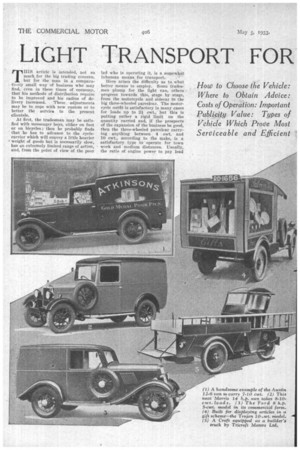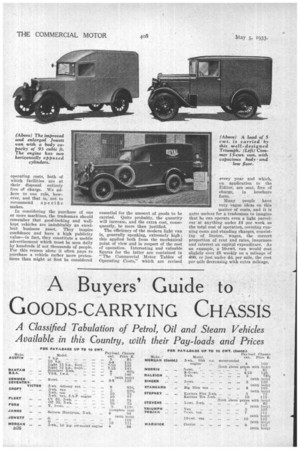LIGHT TRANSPORT FOR
Page 98

Page 99

Page 100

If you've noticed an error in this article please click here to report it so we can fix it.
FRADESMEN
THIS article is intended, not so much for the big trading concern,
• but for the man in a comparathely small way of business who may find, even in these times of economy, that his methods of distribution require to be improved and his radius of de livery increased. These adjustments may be to cope with new custom or to better the serview to the present clientele. .
At first, the tradesman May be satisfied with messenger boys, either on foot or on bicycles ; then he probably finds ' that he has to advance to the cyclecarrier which will convey a little heavier • weight of goods but is necessarily slow, has an extremely limited range of action, and, from the point of view of the poor lad who is operating it, is a somewhat inhuman means for transport.
Here arises the difficulty as to what better means to employ. Some tradesmen plump for the light van, others • progress towards this, stage by stage, from the motorcycle and sidecar tb the big three-wheeled parcelear. The motorcycle outfit is satisfactory in many cases for loads up to 2i• cwt., but this is putting rather a rigid limit • on the quantity 'carried and, if the prospects of the expansion of the business be good,' then the three-wheeled pareelear carrying anything between 4 cwt. and 10 cwt., according to the make, is a satisfactory. type tooperate for town work and medium distances. Usually, the ratio of engine power to pay load is small ; in a few cases excessively so, so that parcelcars are mainly suitable for and employed in, town areas where not many hills abound. This must not be taken as a general condemnation of the hill-climbing capabilities of such machines, but it is. obvious that those with really large-capacity bodies and tiny engines must be limited in this respect. However, they present other advantages. They usually give a large mileage per gallon of fuel and are, in other ways, cheap to operate, whilst their running repairs and cleaning are, to a large extent, well within the capacity of the lads who drive them, if they have sufficient time.
Some of these vehicles are run under contract, and .it is a moot point whether it is not sometimes advantageous to utilize the service afforded by certain concerns which make a speciality of this class of work. This method applies chiefly in the Metropolitan area and in the bigger Provincial centres.
Now we come to the tradesman whose prospects justify the purchase of vans with a capacity of up to, say, 1 ton, for this is the limit to which we are adhering in this article, and here there is a wide choice, ranging from the Austin, Ford and Morris to carry 5 cwt. to the Morris-Commercial. Ford. and International models for 1-ton loads.
This does not, of course, complete the list, as in between there are various sizes of Austin, Commer, B.S.A., JOwett, Morris, Singer, Standard, Triumph, Trojan, Bedford, Dodge Brothers, Ford and Morris-Commercial vehicles; but for the full list we would refer those interested to the useful buyer's guide which is published elsewhere in this issue.
To assist those tradesmen who are in ally difficulty as to the capacity and type of parcelcar and van most suited to their particular transport require-. merits, we extend to them a cordial invitation to make use of our information bureau and the service of our expert on operating costs, both of which facilities are at their disposal entirely free of charge. We adhere to one rule, however, and that is, not to recommend specific makes.
In considering the purchase of one or more machines, the tradesman should remember that good-looking and wellkept vehicles are indubitably an excellent business asset. They inspire confidence and have a high publicity value—in fact, they constitute a mobile advertisement which must be seen daily by hundreds if not thousands of people. For this reason alone it often pays to purchase a vehicle rather more pretentious than might at first be considered essential for the amount of goods to be carried. Quite probably, the quantity will increase, and the extra cost,. consequently, be more than justified.
The efficiency of the modern light van is, generally speaking, extremely high ; this applied both from the mechanical point of view and in respect of the cost of operation. Interesting and valuable figures for the latter are contained in "The Commercial Motor Tables of Operating Costs," which are revised every year and which, on application to the • Editor, are sent, free of charge, in brochure form.
Many people have very vague ideas on this matter of costs, and it is quite useless for a tradesman to imagine that he can operate even a light parcelcar. at anything under £4 per week as the total cost of operation, covering running costs and standing charges, consisting of licence, " wages, the correct proportion of rent and rates, insurance and interest on capital expenditure. As an example, a 10-cwt, van would cost slightly over £6 weekly on a mileage of 400, or just under 4d. per mile, the cost per mile decreasing with extra mileage,




























































































































































































